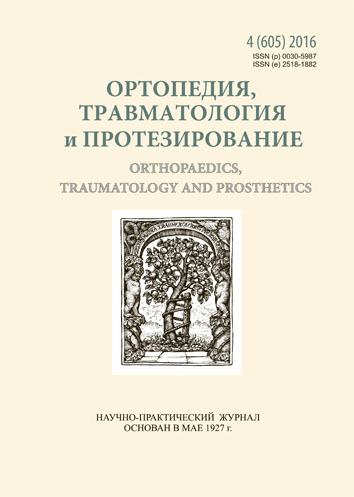Тreatment of long bones comminuted fractures using external fixation device
DOI:
https://doi.org/10.15674/0030-59872016440-46Keywords:
comminuted fractures, diaphyseal fractures, long bones of the limbs, length of injury zone of injury, rod device, periosteal regenerateAbstract
Comminuted fractures consist 35 % out of all diaphysial fractures and require special consideration.
Objective: to determine the features treatment of comminuted diaphyseal fractures of extremities and evaluate the results.
Methods: we treated 63 patients — 65 comminuted diaphyseal fractures of the limbs types B and C by AO classification (7 humerus, femur 18, tibia 35, forearm 3). The length of the zone of damage was 12–20 % of the general bone length in 26 cases, 21-30 % — in 23, 30 % or more — in 16. To fix fractures rod apparatus used. The main thought axial relationships restoration, allowing the residual offset the width ½–⅔ in diameter. A few days later began loading dose and gradually drove him to complete within 2–2.5 months.
Results: rod device fixation of the femur was from 100 to 236 days, shoulder — from 64 to 126, lower leg bones — from 116 to 278, forearm — from 102 to 158 in 4 (6.1 %) patients with comminuted zone bone destruction of more than 30 % of its length nonunion fragments found after 4 months. They underwent autographing keeping in the place the same fixation device, then union reached. All patients fractures healed with the formation of periosteal bone regenerate. A significant limitation of function of the knee or ankle joints were in 4 (6.1 %) patients, when fracture zone extended toward metaepiphyses.
Conclusions: in a case of comminuted diaphyseal fractures of limbs length zone of injury may affect the duration of healing. When it exceeds 30 % of the length of the segment and extends to metaephyses, increases the likelihood for nonunion at diaphyseal level. Sparing of periosteal tissue provides the conditions for the formation of periosteal regenerate, which covers the area of damage.References
- Gorodnichenko AI, Uskov ON. The treatment of comminuted fractures of the shin by rod and spoke fixators. Reporter of Traumatology and Orthopedics named Priorov. 2000;(4): 8-12. (in Russian)
- Bekchanov SZ, Nizamkhadzhaev FM, Mirdzhalimov. Some modern aspects of diagnosis and treatment polyfocal and comminuted fractures of the long bones. Orthopaedics, Traumatology and Prosthetics. 2005;(1):130-3. (in Russian)
- Panov AA, Kopysova VA, Kaplun VA, Petrushin IeG, Tsay DA. Osteosynthesis results for comminuted fractures of long tubular bones. Orthopaedic Genius. 2015;(4):10-6. (in Russian)
- Litvishko V, Uzhigova O. Treatment of diaphyseal fractures of extremities in conditions of traumatology departments of central district highway hospitals. Orthopaedics, Traumatology and Prosthetics. 2012;(2): 68-73. doi: http://dx.doi.org/10.15674/0030-59872012268-73. (in Russian)
- Gustilo RB, Anderson JT. Prevention of infection in the treatment of one thousand and twenty-five open fractures of long bones: retrospective and prospective analyses. J Bone Joint Surg Am. 1976;58(4):453-8.
- Sytenko M.I. Orthopaedics and Traumatology. elected works. Eds. Academic of AMS USSR Korzn AA and prof Pankov IeIa. Kiev: Naukova dumka, 1991: 37-48. (in Russian)
- Popsuishapka O, Litvishko V, Ashukina N. Clinical and morphological stages of bone fragments fusion. Orthopaedics, Traumatology and Prosthetics. 2015;(1): 12-20. doi: http://dx.doi.org/10.15674/0030-59872015112-20. (in Ukranian)
- Novachenko NP, Eliashberg FE. Continual traction. Moskow: Medicine, 1972. 263 p. (in Russian)
- Popsuishapka O, Litvishko V, Borovik I. Functional treatment of diaphyseal fractures of limbs using a rod device for the elastic-resistant joint of fragments: Guidelines. Kyiv, 2014. 46 p.
- Popsuishapka O, Litvishko V, Grigoryev V, Ashukina N. Treatment of bone fragments nonunion after dyaphiseal fracture. Orthopaedics, Traumatology and Prosthetics. 2014;(1): 34-41. doi: http://dx.doi.org/10.15674/0030-59872014134-41. (in Russian)
Downloads
How to Cite
Issue
Section
License
Copyright (c) 2017 Valeriy Litvishko

This work is licensed under a Creative Commons Attribution 4.0 International License.
The authors retain the right of authorship of their manuscript and pass the journal the right of the first publication of this article, which automatically become available from the date of publication under the terms of Creative Commons Attribution License, which allows others to freely distribute the published manuscript with mandatory linking to authors of the original research and the first publication of this one in this journal.
Authors have the right to enter into a separate supplemental agreement on the additional non-exclusive distribution of manuscript in the form in which it was published by the journal (i.e. to put work in electronic storage of an institution or publish as a part of the book) while maintaining the reference to the first publication of the manuscript in this journal.
The editorial policy of the journal allows authors and encourages manuscript accommodation online (i.e. in storage of an institution or on the personal websites) as before submission of the manuscript to the editorial office, and during its editorial processing because it contributes to productive scientific discussion and positively affects the efficiency and dynamics of the published manuscript citation (see The Effect of Open Access).














